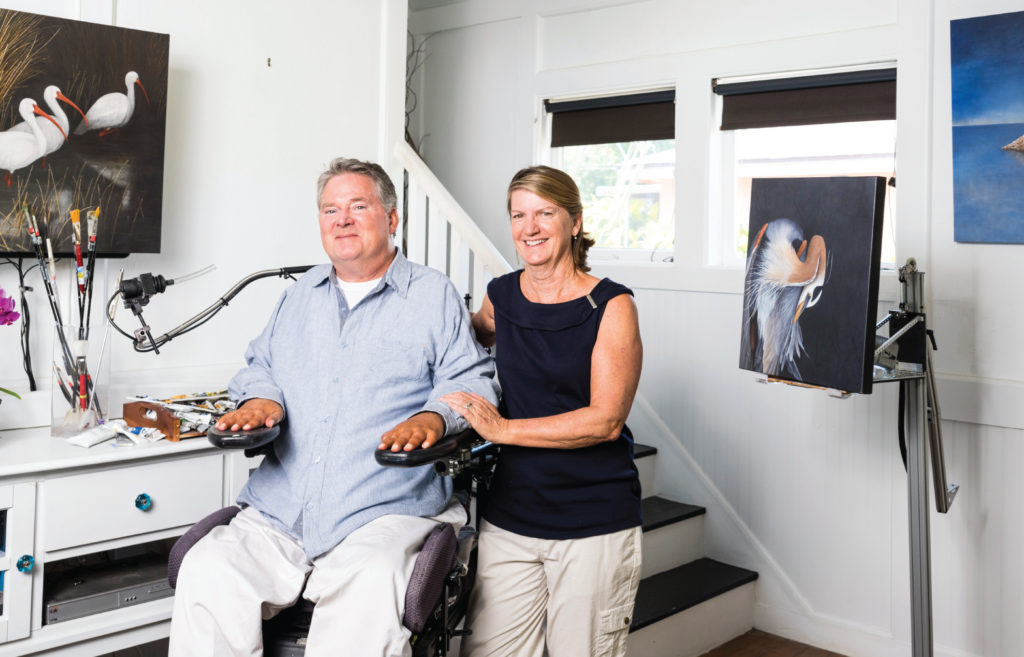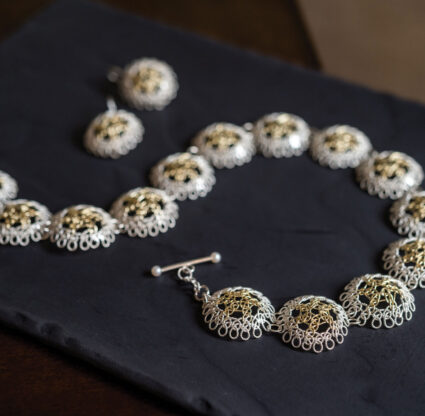Marcus C. Thomas celebrates two birthdays each year. According to one, he is 57. And according to the other, which he marked just about the time I met him last March, he is 31.
He and his wife, Anne, call the latter his “rebirth.”
In his first life, Marcus emerged as the second of four kids with an insatiable energy that led him to all things athletic and outdoors. As a boy, he played baseball and flew model gliders. In his early 20s, he embarked on a wilderness exhibition and worked as a commercial fisherman. He earned his college degree in outdoor recreation. He got a job as a ski instructor in North Carolina, and that’s where Marcus went into a cocoon of sorts, a three-week-long coma, and metamorphosed into the form he holds today.
Conditions on Beech Mountain were poor in the late afternoon of March 3, 1986, but an experienced Marcus was undeterred by the ice-crusted mantle. The mountain got the better of him. He slipped and careened downhill, an oak tree breaking his fall—and his neck.
The accident severed his spinal cord and paralyzed him from the shoulders down. His movement is limited to slight turns of the head—30 degrees (on a good day) to the right, to the left, up and down. He explains this and recounts the accident in the most matter-of-fact tones. If he were distraught in those early months, if he ever pines for his old life, his first one, he’ll never admit to it.
Instead, he focuses exclusively on his magical discovery: You can do a lot with a 30-degree rotation of the neck.
Marcus the athlete disappeared; Marcus the painter was born.
The irony doesn’t dawn on me until later, but the day Marcus and Anne invited me to meet them at their bungalow-style winter home near downtown Fort Myers, Marcus is positioned before a 30-by-60-inch canvas, painting a flight of monarch butterflies.
He indulges my request to watch. His tools are homemade concoctions—brushes attached with tape to carbon fiber tubes that in turn are fitted to a mouthpiece. Earlier that morning, Anne, who’s out in her workshop framing prints, had squeezed oil paints onto a palette. Marcus dips thin bristles into black paint and outlines wings. The brush is steady and his movements deft, if barely discernible.
“It’s kind of like watching grass grow,” he says after a few minutes, managing a wry smile through clutched teeth. Anne, who started dating him when they were 23 and married him on Sanibel 10 years after the accident, fell in love—and stayed in love—largely for his humor and unflappable optimism.
The insects, about two dozen of them, are positioned against a backdrop of blue sky and rolling green hills. Later, he explains that the piece, Monarch Migration, is a tribute to the insects’ annual pilgrimage, a journey that takes them through Western Carolina. Over the years, he’s watched their numbers shrink with environmental change and habitat loss; he wants to remind viewers of their fragile beauty.
 |
|
Shellbirds |
If you were to see Migration without knowing the artist, you’d imagine that the painter had created the landscape with broad, sweeping strokes. And in fact, Anne once overheard a viewer sneer, “I’m sure she does the backgrounds.” It was all she could do to contain her temper. “I never thought anyone could think like that,” she says.
If her husband’s work had stayed at the “cartoonish” level of his early career, the couple would never encounter such cynicism. But the truth is, his paintings are good—unbelievably good—and for three decades, the couple has made their living entirely through sales of Marcus’ art.
The illusion of expansiveness is really just a technique Marcus developed through experimentation, relying on “small brushes and lots of time.” A painting takes about four to six weeks, working in roughly 12-by-12-inch increments.
“I will in my mind block things off and work in segments,” he explains. “It’s like a puzzle. I have a big picture in my mind, and that always grounds me.”
This morning, though, he and Anne are excited over the prospect of two potentially life-altering, time-saving devices delivered to Marcus a week before. Anne’s brother Michael Gahagan, a newly retired senior project manager for Visa who also lives in Fort Myers, has a knack for engineering and software design. He created two voice-activated contraptions: a robotic easel and a mechanical arm that attaches to Marcus’ wheelchair. It holds up to three paintbrushes and rotates so that Marcus can change tools at will, liberation for him and for Anne, who until now has shifted canvases and fetched brushes.
“Roger. Roger,” Marcus beckons. The machine beeps in response. “Left easel.”
It takes a couple of tries to activate fully—they’re still working out some kinks—but “Roger” complies and the easel’s base shifts sideways. Both devices have tremendous implications, for him and for others living with paralysis or other limitations. The family intends to patent them.
“This is huge,” Anne says.
|
|
Discovering Marcus’ talent was as accidental as his fateful fall. About six months after discharge, Marcus’ sister and Anne on a whim bought watercolors and a paintbrush altered to fit his mouth, hoping to offer an outlet.
His first work: a Christmas scene swirled with bright colors, a smiley face, a sleigh and a greeting, “Merry Cosmic Christmas.” It was Marcus to the core—full of cheer and quirky wit. He and Anne were living with Marcus’ parents in Virginia at the time, getting their footing and redefining “normal.” Anne worked as an accountant during the day; Marcus practiced painting. By the end of 1987, he had produced 12 wildlife and landscape pieces of respectable quality. Anne had the works assembled into a calendar, ordered 1,000 copies and immediately thought, “Holy smokes, what are we gonna do with all these calendars?”
They did the only thing they could think of at the time: bundle up and go door-to-door through the neighborhood, Anne on foot, Marcus in chair, peddling calendars for $10 apiece. Three decades later, they laugh at their younger selves.
“I don’t know why we thought we could do it, but we did,” Marcus says. “We didn’t overanalyze very much and we didn’t question things. We just went with our instincts.”
 |
|
Wedgewood |
Neighbors encouraged the budding artist to keep going.
Marcus had never been much of a student, but now he pushed headlong into the study of art, both history and technique. He delved into literature, too, and literary references show up from time to time—a raven, a portrait of Ernest Hemingway, the wreckage of the Pequod, for example.
The outdoorsman derives much of his inspiration from nature, painting plant and animal life with a particular affinity for birds. In some works, like Ibis at Bailey Tract, the birds seem to pop out of subdued, understated backgrounds. In others, like Gingko and Phoebe, they’re set against elaborate wooded and floral backdrops. Travel influences other works, though these pieces, too, mostly depict places pastoral and serene.
In the past decade, Marcus has veered into abstract, conceptual and symbolic work.
“I’m trying to be more of an artist, freer in thought,” he says. “More painterly, more ideas that have different parallels, like a multilayered story within one painting. … More of the unexpected.”
How Time Flies, his symbolic self-portrait, depicts a raven in flight. Its talons clutch a pocket watch (Anne’s gift to Marcus on his 24th birthday). In place of the face is Marcus’ bright blue eye. The gears, the watch’s “inners,” spill out the bottom. Fluttering in the bird’s wake is a ragged sheet of paper and poem he wrote, lamenting the all-too-swift passage of time.
“Oh man, time is fleeting. It is for all of us. It’s just so fast,” he says.
Anne reappears toward the end of the conversation. She’s as personable as her husband but prefers backstage to the spotlight.
“She does it all,” Marcus says. “Organizes the business, takes care of me, takes care of this place, the place in North Carolina. She is amazing and the reason why we are who we are.”
They say they never considered not staying together. “I know it’s odd, but we just got focused on what was before us and to live each day one at a time and do what we had to do,” Anne says.
In a way, the accident was a rebirth for Anne, too. “I had gone to school for a while, but I didn’t really enjoy it. I don’t even know what I would be doing (if the accident hadn’t happened).”
 |
|
How Time Flies |
She brings me to her backyard workshop to show her side of the business—the care and keeping of Marcus’ work, the framing, printing and preparation that go into the art shows. She’ll hang a mix of paintings: nature scenes that are a sure bet with patrons, as well as abstracts that are riskier commercially but demonstrate her husband’s range.
Anne is creative in her own right. She’s just mastered a new framing technique that involves laying a print in a box-like frame, covering it with an epoxy resin, curing it and setting it under blowtorch heat. She’s been experimenting with new ways of using Marcus’ images, too, like a set of prints that features Marcus’ songbirds and elegantly typeset verses of Emily Dickinson and Douglas Malloch.
“I’m the kind of person who needs to be moving all the time. I really can’t do the same thing every day,” Anne says. “My mind just doesn’t focus very well. I get my jobs done. I may not get them done in the right order or anything, but they do get done. I make it happen in my own way, and it works. Actually, this is probably the perfect job for me. No rules.”
In their 50s now, the couple is scaling back on art shows, favoring day trips to overnight stays. Marcus is hoping to sell more originals, and with his new easel, tackle larger canvases. Anne chuckles and says her job is making sure Marcus doesn’t overexert himself with his new “toys.”
But the painter long ago had transferred his irrepressible energy from body to mind, making each day a race to convey his thoughts on canvas.
“I have so many ideas in my head. There’s just not enough time. I don’t think I’ll ever run out of things to do. That’s comforting to me,” Marcus says.
Former Gulfshore Life intern Emily Rose contributed to this piece.






